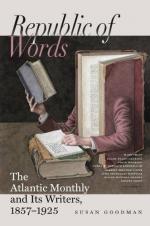And with these receding plants go also the special insects which haunt them. Who that knew that pure enthusiast, Dr. Harris, but remembers the accustomed lamentations of the entomologist over the departure of these winged companions of his lifetime? Not the benevolent Mr. John Beeson more tenderly mourns the decay of the Indians than he the exodus of these more delicate native tribes. In a letter which I happened to receive from him a short time previous to his death, he thus renewed the lament:—“I mourn for the loss of many of the beautiful plants and insects that were once found in this vicinity. Clethra, Rhodora, Sanguinaria, Viola debilis, Viola acuta, Dracoena borealis, Rhexia, Cypripedium, Corallorhiza verna, Orchis spectabilis, with others of less note, have been rooted out by the so-called hand of improvement. Cicindela rugifrons, Helluo proeusta, Sphoeroderus stenostomus, Blethisa quadricollis, (Americana mi,) Carabus, Horia, (which for several years occurred in profusion on the sands beyond Mount Auburn,) with others, have entirely disappeared from their former haunts, driven away, or exterminated perhaps, by the changes effected therein. There may still remain in your vicinity some sequestered spots, congenial to these and other rarities, which may reward the botanist and the entomologist who will search them carefully. Perhaps you may find there the pretty coccinella-shaped, silver-margined Omophron, or the still rarer Panagoeus fasciatus, of which I once took two specimens on Wellington’s Hill, but have not seen it since.” Is not this indeed handling one’s specimens “gently as if you loved them,” as Isaak Walton bids the angler do with his worm?
There is this merit, at least, among the coarser crew of imported flowers, that they bring their own proper names with them, and we know precisely whom we have to deal with. In speaking of our own native flowers, we must either be careless and inaccurate, or else resort sometimes to the Latin, in spite of the indignation of friends. There is something yet to be said on this point. In England, where the old household and monkish names adhere, they are sufficient for popular and poetic purposes, and the familiar use of scientific names seems an affectation. But here, where many native flowers have no popular names at all, and others are called confessedly by wrong ones,—where it really costs less trouble to use Latin names than English, the affectation seems the other way. Think of the long list of wild-flowers where the Latin name is spontaneously used by all who speak of the flower: as, Arethusa, Aster, Cistus, ("after the fall of the cistus-flower,”) Clematis, Clethra, Geranium, Iris, Lobdia, Bhodora, Spirtea, Tiarella, Trientalis, and so on. Even those formed from proper names (the worst possible system of nomenclature) become tolerable at last, and we forget the man in the more attractive flower. Are those who pick the Houstonia to be supposed thereby to indorse the Texan President? Or are the deluded damsels who chew Cassia-buds to be regarded as swallowing the late Secretary of State? The names have long since been made over to the flowers, and every questionable aroma has vanished. When the godfather happens to be a botanist, there is a peculiar fitness in the association; the Linaea, at least, would not smell so sweet by any other name.




